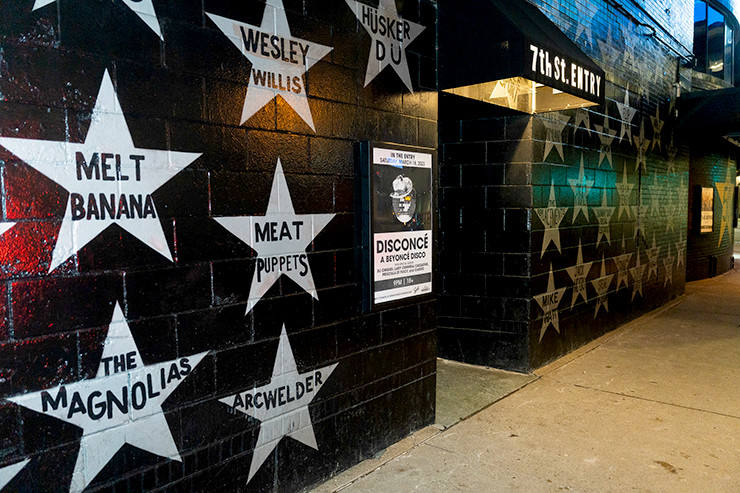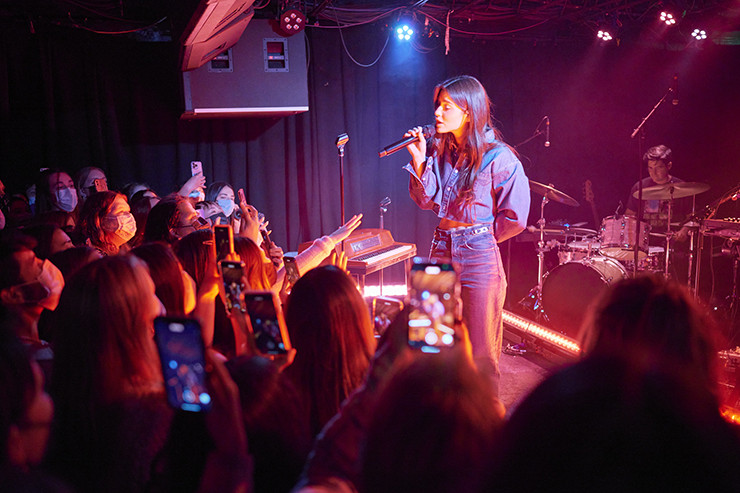The 7th Street Entry in Minneapolis doesn’t just create memories; it etches them with an intensity that stays with you. This venue is a vibrant, raw, and personal space, forging a powerful connection between artists and audiences that can last a lifetime.
Chrissie Hynde, the iconic frontwoman of The Pretenders, understands this unique atmosphere deeply. After commanding a crowd of 50,000 at Toronto’s Rogers Centre as Guns N’ Roses’ opening act, The Pretenders chose to perform for just 250 people at the Entry on a Thursday night, highlighting the venue’s special draw.
While The Pretenders could have easily chosen First Avenue, the larger, more famous nightclub next door, they opted for the Entry’s distinct vibe. First Avenue, accessible through a connecting doorway it shares space with the Entry in a former Greyhound bus terminal, is where The Pretenders made their Minneapolis debut in April 1980, a show that helped solidify the club’s shift away from disco.
However, First Avenue has evolved into an international landmark, celebrated as the setting for Prince’s legendary performances in the 1984 film “Purple Rain” and a pilgrimage site for fans honoring his legacy since 2015.
The Entry possesses a different kind of allure. It’s less globally recognized, yet incredibly impactful in its own right.
The Birth of a Legendary Venue
The first official performance at the 7th Street Entry was by Curtiss A (Almsted) in March 1980. However, Steve McClellan, who managed both the Entry and First Avenue for over three decades, recalls that The Wallets were already playing there informally before that date.
Jim Walsh, a writer and musician who performed at the Entry with two bands and documented its scene for various publications, including the U of M Daily and City Pages, remembers the raw energy of those early days. “(Wallets front man) Steve Kramer jumped on the bar and tightrope-walked his way down to the cash register, ripped out some bills and started throwing change, singing a song I don’t think they had even recorded yet.”
In its initial years, the bar and stage were in reversed positions compared to today. McClellan recounts the makeshift, underfunded nature of the venue’s beginnings. Originally, the space served as a coat check for Uncle Sam’s, the disco that preceded First Avenue. Upon removing a wall, they discovered the space had once been a diner within the Greyhound station.
“I still have an old menu in a box somewhere,” McClellan said. “I didn’t keep the jars of pickles that we found.”
Throughout the 1980s, the 7th Street Entry developed its iconic, slightly rundown character. Leaks in the roof, a perpetually clogged bathroom toilet adorned with layers of graffiti, and an intensely black color scheme even more pervasive than First Avenue’s contributed to its atmosphere. With low ceilings in a compact area, the ever-present cigarette smoke led some to jokingly call it “The Ashtray.”
 7th Street Entry
7th Street Entry
But this intimate, almost claustrophobic setting fostered an unparalleled connection between the music and the audience. The low ceilings, hard, soot-stained walls, and sharp angles surprisingly created an acoustic sweet spot, even at high volumes.
Adding to the appeal was the unpredictable proximity to performers. In the early days, McClellan aimed to feature reggae and “world music” acts. Flyte Tyme—the precursor to The Time, featuring Jimmy Jam and Terry Lewis before Morris Day—performed at the Entry.
Jim Walsh recounts a memorable night: “I remember a night when the Pedal Jets, a band from Lawrence, Kansas, was scheduled to play. Prince walked in with three members of The Revolution—this was right after ‘Purple Rain’ had peaked—and he said we’re not as good as the band that’s here tonight, but we’re going to play a little. And they did about 30 minutes.”
Beyond these exceptional moments, the 7th Street Entry in the 80s and early 90s increasingly became a haven for raw rock ‘n’ roll. The Longhorn, another downtown venue for punk and new wave, closed shortly after the Entry opened. While some were initially deterred by the Entry’s dilapidated state, local punk fans drew parallels between the small, gritty space and the legendary CBGB in New York City.
“Within a few years, the market, not me, had decided the Entry was not going to be a diverse room. It was going to be a punk club,” McClellan stated.
And a remarkable punk club it became. Bands spearheading the punk element of the “Minneapolis Sound”—The Replacements and Hüsker Dü—thrived at the 7th Street Entry, paving the way for the national grunge and hard rock movements of Nirvana, Green Day, and The Pixies. Hüsker Dü’s debut album was recorded live at the Entry, and The Replacements’ week-long residency there became legendary, a tradition later echoed by Slug and Atmosphere with their own week-long hip-hop performances as the venue embraced hip hop in the mid-to-late 90s.
Before First Avenue’s rise to national fame, the 7th Street Entry was the financial engine of the building. As First Avenue gained prominence, successful local bands from the Entry were often rewarded with opening or headlining slots in the larger venue.
“It was a breeding ground,” Walsh said. “You’d play the Entry and then Steve might say, ‘Hey, you want to open for the Ramones?’ And then when they started the Best New Bands of the Year, they’d all play at the Entry around New Year’s Eve.”
Hip-Hop’s Arrival and Community Growth
A decade after Walsh, Peter Scholtes, another musician and former City Pages writer, also played in bands and chronicled the 7th Street Entry scene. Reflecting on the sense of community, he recalled, “…going to Stereolab (an indie rock band) in the early ‘90s and the whole room vibrating to the same pulse. It’s this joy, like when everybody is laughing together in a theater. There is no better place to see a great live band. The sound and sense of togetherness is just so immediate.”
Scholtes, who has extensively documented the history of hip hop in the Twin Cities, recognized the Entry as a crucial launchpad for the genre locally, starting with I Self Divine with the Micranots, and later Atmosphere and other artists from the Rhymesayers Entertainment collective.
The integration of hip-hop into the Entry’s programming drew John Labree to become a regular, a habit he maintains today. “It became a scene spot, where you knew Headshots or Rhymesayers were going to be playing.”
The unpredictable nature of the shows keeps him returning. “It could be just you and the guy who sells merch for the band in the place, or it could be a bunch of fanatics who are super into it and (the performer) is inspired and meets the moment. But knowing you were there watching people break into the scene, where the Entry is a big gig, and seeing them get bigger, it is pretty cool.”
 Singer-songwriter Gracie Abrams performing in the 7th Street Entry.
Singer-songwriter Gracie Abrams performing in the 7th Street Entry.
“Then there is the setup of the space itself,” Labree continued. “Like I came out of the restroom and took a picture of (the Australian jazz band) Surprise Chef, and people on my feed were saying, ‘Are you in the band?’ and ‘Were you on stage?’ No, it’s just everything is so close together.”
Still Unpredictable, Still Rewarding
The 7th Street Entry now has two restrooms, generally clean and free of graffiti. While some behind-the-scenes renovations have occurred, the public-facing layout remains largely unchanged—if it works, don’t fix it. Seating is still limited. Along the back wall, there’s a raised, two-tiered area reminiscent of a shoeshine stand, and a dozen or so stools line the ledge separating this area from the lower floor in front of the stage, which can accommodate around 70 people.
My own first experience at the Entry was shortly after moving to Minneapolis in 1985, seeing the thrash band The Minutemen. The sound was incredibly intense, like a tuning fork striking the Liberty Bell right next to my eardrums. I’ve returned somewhat regularly since then (pausing during COVID), but recently attended about a dozen shows in August to get a fresh perspective on the venue.
Initially, one might think the Entry may never recapture its 80s punk heyday or the hip-hop energy of Atmosphere’s week-long takeovers in the early 2000s. However, this perspective might be skewed by the tendency to remember the most vivid and positive memories most strongly.
Labree is right about the charm of unpredictability. If you have the time and budget (most shows are under $20, but frequent visits can add up), the variety is captivating. The range of genres and band recognition is perhaps wider than ever. I witnessed country-folk, hip-hop, aggressive punk rock, melodic soft rock, and even bubblegum pop with singers using computer mixes instead of live bands.
 Singer-songwriter Gracie Abrams performing in the 7th Street Entry.
Singer-songwriter Gracie Abrams performing in the 7th Street Entry.
Even sparsely attended shows are filled with a sense of community. A gender-fluid trio of Black performers drew an enthusiastic LGBTQ+ crowd who spontaneously line-danced to a drag queen lip-syncing Erykah Badu’s “Tyrone.” Two earnest hard rock openers each brought dedicated groups resembling enduring high school cliques. And, almost invariably, parents and grandparents of local acts are easily spotted in the audience. “My mother still talks about the time she went to the Entry and saw all three of her sons in different bands on the same night,” Walsh said.
You never know when you’ll witness something extraordinary. Scholtes estimates he was among only 20 people present for an early White Stripes performance at the Entry. Walsh brought his daughter to see Billie Eilish at the 7th Street Entry in 2017, a year before she achieved mainstream stardom.
During my August visits, I saw Sweeping Promises, a Boston duo now based in Lawrence, Kansas, touring with a drummer. The singer was a powerful vocalist and insightful lyricist; the guitarist a brilliant minimalist. It’s unlikely I’ll ever see them in such an intimate setting again.
I also saw Student 1, the third of five hip-hop acts one evening. A first-generation American of Ethiopian descent, raised in Minneapolis after moving from Maryland at age three, his demeanor was confidently relaxed, his movements fluid, his raps light yet sharp, catchy and engaging. Where previous and subsequent acts often fell into predictable aggression or hype, Student 1 seemed thoughtful even in his quickest phrases, and even lay down on stage during one of his two “slow songs.” It was a unique, memorable performance, perfectly embodying the spirit of the 7th Street Entry Minneapolis.
